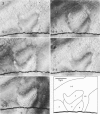Abstract
Reconstruction from thick serial transverse slices of frog skeletal muscle fibers stained with peroxidase and examined by high-voltage electron microscopy has revealed that the T system networks at successive sarcomeres are connected together in a helicoidal fashion. From zero to eight helicoids have been found in each of a group of 21 fibers reconstructed in cross section. Helicoids can have either right- or left-handed screw senses, and both senses can be found in one fiber cross section. Because the T system maintains a relatively precise alignment with the myofibrillar striations, it follows that the striations must also have a helicoidal arrangement. This has been found before, but has not been widely accepted in recent times. The presence of helicoids in the bands and membrane networks is not thought per se to alter very much our thinking about excitation and contraction mechanisms in skeletal muscle fibers.
Full text
PDF









Images in this article
Selected References
These references are in PubMed. This may not be the complete list of references from this article.
- Costantin L. L. Contractile activation in skeletal muscle. Prog Biophys Mol Biol. 1975;29(2):197–224. doi: 10.1016/0079-6107(76)90023-7. [DOI] [PubMed] [Google Scholar]
- Eisenberg B., Eisenberg R. S. Selective disruption of the sarcotubular system in frog sartorius muscle. A quantitative study with exogenous peroxidase as a marker. J Cell Biol. 1968 Nov;39(2):451–467. doi: 10.1083/jcb.39.2.451. [DOI] [PMC free article] [PubMed] [Google Scholar]
- Jasper D. Body muscles of the lamprey. Some structural features of the T system and sarcolemma. J Cell Biol. 1967 Jan;32(1):219–227. doi: 10.1083/jcb.32.1.219. [DOI] [PMC free article] [PubMed] [Google Scholar]
- PORTER K. R., PALADE G. E. Studies on the endoplasmic reticulum. III. Its form and distribution in striated muscle cells. J Biophys Biochem Cytol. 1957 Mar 25;3(2):269–300. doi: 10.1083/jcb.3.2.269. [DOI] [PMC free article] [PubMed] [Google Scholar]
- Page S. G. A comparison of the fine structures of frog slow and twitch muscle fibers. J Cell Biol. 1965 Aug;26(2):477–497. doi: 10.1083/jcb.26.2.477. [DOI] [PMC free article] [PubMed] [Google Scholar]
- Peachey L. D., Schild R. F. The distribution of the T-system along the sarcomeres of frog and toad sartorius muscles. J Physiol. 1968 Jan;194(1):249–258. doi: 10.1113/jphysiol.1968.sp008405. [DOI] [PMC free article] [PubMed] [Google Scholar]
- Peachey L. D. The sarcoplasmic reticulum and transverse tubules of the frog's sartorius. J Cell Biol. 1965 Jun;25(3 Suppl):209–231. doi: 10.1083/jcb.25.3.209. [DOI] [PubMed] [Google Scholar]






